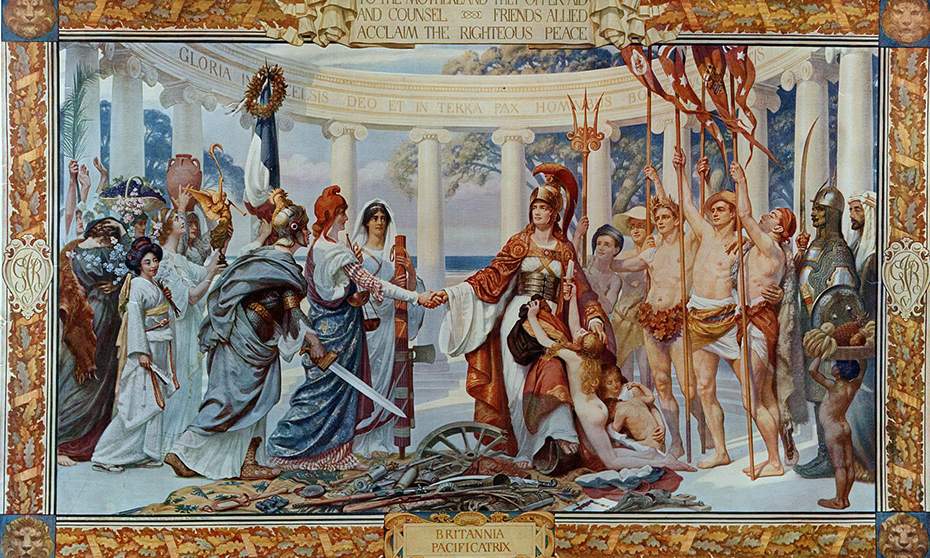Not only sculptures: now the wave of review of controversial artworks in Anglo-Saxon countries has also targeted paintings. Last week, in the United Kingdom, Labour politician Lisa Nandy, shadow foreign minister, wrote a letter to British Foreign Secretary Dominic Raab to ask the latter what his position is on some large canvases that decorate the headquarters of the Foreign Office, the U.K.’s foreign ministry. The paintings in question date from the period 1914-1921, are the work of British painter Sigismund Goetze (London, 1866 - 1939) and depict the origin, education, development, expansion and triumph of the British Empire: they are strongly didactic works that bear the influence of painting developed in England during the Victorian era.
They are five large paintings (each dedicated to the five themes mentioned above: Britannia Sponsa, the origin of the empire; Britannia Bellatrix, development; Britannia Colonorum Mater, expansion; Britannia Nutrix, education; Britannia Pacificatrix, triumph), with a clear celebratory intent, but the content is now seen as uncomfortable, given the strong imperialist emphasis of the depictions: particularly troublesome is the last of the canvases, the one with the triumph of the British Empire, where Britannia Pacificatrix, personification of the empire, is depicted in the act of shaking hands with the personification of the United States. The latter is flanked by the other nations of the world: there is also Italy, depicted as a woman dressed in white and holding the fascio littorio, which has nothing to do with the fascism that would soon come to power, but is the symbol of Roman law. We then note Japan (an almond-eyed woman in traditional dress), France (the soldier carrying the nation’s banner and pointing his sword downward where there are broken weapons, a symbol of defeated Germany: we notice this from the typical headgear of the German army in World War I), Greece (the woman holding the statue of fame), Romania (carrying a jar on her head).
The British Empire, which with its cloak protects the countries victimized in World War I (such as Belgium, represented by a naked woman clutching the Empire’s knees while holding the country’s flag), advances along with other states that were then not yet independent and were part of the Empire (Canada, Australia, South Africa, New Zealand), depicted as naked men carrying banners and following the Britannia Pacificatrix. Then there are the personifications of the dominions in India and Arab countries (on the right) and a naked black child with a basket of exotic fruit on his head, appearing in the lower right corner, who is called “a little Swahili boy” in a Goetze-era document, and who is reminiscent of the British Empire’s role in Africa.
Annoying is the tone of the work, which is considered racist: “the painting,” historian Alexander Mirkovic told the Guardian, “shows how Britain’s racial worldview was ordered. The Anglo-Saxons, the superior race, show their naked bodies but cover their pudenda; the inferior races, such as the Indians and Arabs, are clothed in full dress, and the last of the races, the Africans, is depicted as a naked infant. Here we have a clearly body-centered racial meta-narrative.”
So there are those who would like to see these paintings dismantled: among others, international relations expert David Wearing, author of an article published today in the Guardian, in which he calls for the removal of the squares. “The problem,” Wearing argued, “lies not in the ’offensive’ words and images, but in the ideological implications of state violence against rationalized ’others.’ This ideology, exemplified in the Foreign Office murals, has its roots in the centuries of empire that formed modern Britain and its relations with the rest of the world, especially the global south. Now it is therefore urgent to show this legacy and confront it, and then dismantle it.”
Of a different opinion is cultural historian Caroline Dakers, who teaches Cultural History at the University of the Arts, London, and is moreover a specialist on Goetze’s art: “I can understand,” she said, “why people feel that these paintings should be removed from a government seat, but I think that then they should be stored elsewhere, for example in a museum. We can discuss this on multiple levels and reach a broader understanding of why Britain had these views on the subject of empire.” Dakers also pointed out that there is currently no museum in the United Kingdom dedicated to the country’s history.
At the moment, the British Foreign Office has taken note of the grievances, letting it know that the works (paintings, statues and more) that are inside the venue will be examined to ensure that they can be more representative of the UK today, but without rewriting its history, but preserving it.
Pictured is the painting Britannia Pacificatrix by Sigismund Goetze.
 |
| After sculptures, paintings in England are now also targeted, with proposals to dismantle them |
Warning: the translation into English of the original Italian article was created using automatic tools. We undertake to review all articles, but we do not guarantee the total absence of inaccuracies in the translation due to the program. You can find the original by clicking on the ITA button. If you find any mistake,please contact us.